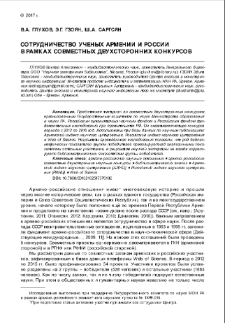Object
Title: Assessment of scientific cooperation between the scientists from armenia andrussia within the joint bilateral grant projects ; СОТРУДНИЧЕСТВО УЧЕНЫХ АРМЕНИИ И РОССИИВ РАМКАХ СОВМЕСТНЫХ ДВУХСТОРОННИХ КОНКУРСОВ
Co-author(s) :
Gzoyan Edita ; Sargsyan Shushanik ; Гзоян Эдита ; Саргсян Шушаник
Abstract:
Armenian-Russian scientific relations have a solid historical basis, developed both within the same state and on the level of independent states. After the collapse of the Soviet Union the Russian Federation and the Republic of Armenia have signed a number of agreements to regulate and enhance existing scientific relations. Starting from 2012 state-sponsored bilateral grant competitions were the next important step in deepening the existing scientific ties and building new cooperation. The article discusses Armenian-Russian bilateral grant projects organized jointly by the State Committee of Sciences of the Ministry of Education and Science of the Republic of Armenia and the Russian National Foundation for Humanities and the Russian Foundation for Basic Research under the Government of the Russian Federation. Within the framework of cooperation between these bodies on the contractual basis 5 grant projects have been organized so far. However, only 4 projects are discussed in this article as the last one has started very recently and it is too early to speak about the results. The study is based on the databases of Thomson Reuters’ Web of Science (WOS), eLibrary’s Russian Index of Scientific Citation (RINC) and Armenian Index of Scientific Citation (AINC) developed by the Center for Scientific Information Analysis and Monitoring. Publications of the participants of the grant projects indexed in WOS were considered from 2006 till 2015, RINC – 1991–2015 and AINC – 2007–2012 (the difference in timeframes is connected with the availability of the resources). The period of investigation captures 1991 to 2015, although in some cases it goes deep into 1981. For the implementation of this research such bibliometric indicators as author’s publication number, citation number, self citation number, average citation per item, H-index, impact factor of the journals were used. The participants of the grant projects were divided into two groups: the winners and the other participants. Bibliometric indicators, ages as well as scientific degrees of these two groups were compared. The influence of these bilateral grants projects on the overall Armenian-Russian scientific cooperation was also highlighted. Basing on our investigation we came to the conclusion that in some cases bibliometric indicators of the other participants’ group prevail over the winners’ group, while the results of the grants peer-review process not always correlate with the bibliometric indicators of the winning group.
;
Представлен материал по совместным двухсторонним конкурсам, организованным Государственным комитетом по науке Министерства образования и науки РА, Российским гуманитарным научным фондом и Российским фондом фундаментальных исследований при правительстве РФ. Он охватывает четыре конкурса периода с 2012 по 2015 год. Использованы три базы данных по научным публикациям: Армянский индекс научного цитирования, Российский индекс научного цитирования и Web of Science. Результаты проведённого исследования показали, что ряд библиометрических показателей группы победителей превалируют над аналогичными показателями остальных участников, а результаты научной экспертизы не всегда коррелируют с библиометрическими показателями группы победителей
Degree name:
Cand. Sci. (Hist.) ; Cand. Sci. (Techn.) ; Cand. Sci (Biol.) ; кандидат технических наук ; кандидат исторических наук ; кандидат биологических наук
Date created:
Date submitted:
Date accepted:
Date of publication:
Identifier:
oai:noad.sci.am:135777
DOI:
Language:
Journal or Publication Title:
Sociological Studies ; Социологические исследования
Volume:
URL:
Additional Information:
editagzoyan@gmail.com ; glukhov@elibrary.ru ; shushanik@ipia.sci.am
Affiliation:
Scientific Digital Library ; Institute for Informatics and Automation Problems ; Научная электронная библиотека ; Института проблем информатики и автоматизации ; Центра анализа и мониторинга научной информации
Country:
Indexing:
Object collections:
- Digital Library > Academic Insitutions > Insitute for Informatics and Automation Problems of NAS RA > Publications
Last modified:
Mar 3, 2021
In our library since:
Jul 15, 2020
Number of object content hits:
135
All available object's versions:
https://noad.sci.am/publication/149304
Show description in RDF format:
Show description in OAI-PMH format:
| Edition name | Date |
|---|---|
| В.А. ГЛУХОВ, СОТРУДНИЧЕСТВО УЧЕНЫХ АРМЕНИИ И РОССИИВ РАМКАХ СОВМЕСТНЫХ ДВУХСТОРОННИХ КОНКУРСОВ | Mar 3, 2021 |





